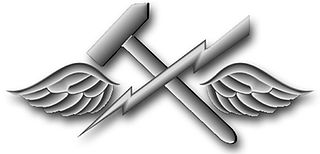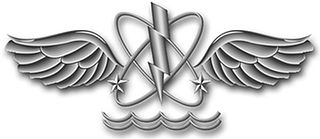Related Research Articles

AAI Corporation is an aerospace and defense development and manufacturing firm, located in Hunt Valley, Maryland, US. Formerly a wholly owned subsidiary of United Industrial Corporation, AAI was acquired by Textron in 2007. It currently operates as a unit of Textron Systems and employs more than 2,000.

An aircraft mechanic, aviation mechanic or aircraft maintenance technician (AMT) is a tradesperson who carries out aircraft maintenance and repairs. AMTs inspect and perform or supervise maintenance, preventive maintenance, repairs and alteration of aircraft and aircraft systems.
Historically, an armourer is a person who makes personal armour, especially plate armour. Historically armourers were often men, but women could also undertake the occupation: for example Alice la Haubergere worked as an armourer in Cheapside in the early 1300s and in 1348 Eustachia l’Armurer was training her husband's daughter, likely in the field.
The Air Force Specialty Code (AFSC) is an alphanumeric code used by the United States Air Force to identify a specific job. Officer AFSCs consist of four characters and enlisted AFSCs consist of five characters. A letter prefix or suffix may be used with an AFSC when more specific identification of position requirements and individual qualifications is necessary. The AFSC is similar to the Military Occupational Specialty Codes used by the United States Army and the United States Marine Corps or enlisted ratings and USN officer designators and Naval Officer Billet Classifications (NOBCs) used by the United States Navy and enlisted ratings and USCG officer specialties used by the United States Coast Guard. The United States Space Force equivalent is known as the Space Force Specialty Code (SFSC).

Coast Guard Air Station Elizabeth City is a United States Coast Guard Air Station co-located at Elizabeth City Regional Airport in Elizabeth City, North Carolina, along the Pasquotank River near the opening of the Albemarle Sound. The Coast Guard air station is one of the busiest in the U.S. Coast Guard, operating missions as far away as Greenland, the Azores and the Caribbean.

A naval aviator is a commissioned officer or warrant officer qualified as a crewed aircraft pilot in the United States Navy or United States Marine Corps. United States Coast Guard crewed aircraft pilots are officially designated as "Coast Guard aviators", although they complete the same undergraduate flight training as Navy and Marine Corps crewed aircraft pilots, and are awarded the same aviation breast insignia.
A parachute rigger is a person who is trained or licensed to pack, maintain or repair parachutes. A rigger is required to understand fabrics, hardware, webbing, regulations, sewing, packing, and other aspects related to the building, packing, repair, and maintenance of parachutes.

Radioman (RM) was a rating for United States Navy and United States Coast Guard enlisted personnel, specializing in communications technology.

Aviation electronics technician (AT) is a US Navy enlisted rating or job specialty. At the paygrade of E-9, ATs merge with the aviation electrician's mate (AE) rating to become avionics technicians (AV). There has been talk of completely merging the two ratings, but as yet no definite plans have been announced. Aviation electronics technicians wear the specialty mark of a winged helium atom.

Aviation Survival Technician (AST) is a rating or job specialty in the United States Coast Guard. Rescue swimmer is the collateral duty or aircrew position of the AST. They are trained at the U.S. Coast Guard's enlisted Aviation Survival Technician/Rescue Swimmer school at Coast Guard Aviation Technical Training Center, Coast Guard Air Station Elizabeth City in Elizabeth City, North Carolina.

Aviation Machinist's Mates are United States Navy aircraft engine mechanics that inspect, adjust, test, repair, and overhaul aircraft engines and propellers. More specifically, ADs install, maintain, and service various aircraft engine types as well as various accessories, gear boxes, related fuel systems, and lubrication systems; determine reasons for engine degradation using various test equipment; perform propeller repairs; handle and service aircraft ashore or aboard ship; and can also serve as aircrewman in various types of aircraft.

Aviation Support Equipment Technician is a United States Navy occupational rating. The United States Marine Corps currently maintains 3 separate aviation support equipment military occupational specialties. They are: 6071, 6072 aircraft maintenance support equipment hydraulic/ pneumatic structures mechanic and 6073 aircraft maintenance support equipment electrician / refrigeration mechanic.

Naval Aircrewman (NAC) is an enlisted general rating of the U.S. Navy. Sailors in NAC ratings serve as aircraft systems operators or inflight system maintenance technicians aboard U. S. Navy fixed and rotary winged aircraft. They perform duties as varied as aerial gunners, rescue swimmers, radar and sonar operators, airborne mine countermeasures system operators, strategic communications systems specialists, loadmasters, repair technicians, and various other functions depending on the specific aircraft type in which they fly. The rating is divided into five subdivisions termed "service ratings". Those service ratings are: Naval Aircrewman Operator (AWO); Naval Aircrewman Helicopter (AWS); Naval Aircrewman Tactical Helicopter (AWR); Naval Aircrewman Mechanical (AWF); and Naval Aircrewman Avionics (AWV). All five service ratings are identified by a single AW Rating Badge. Many technologically advanced navies have a similar trade. To date the greatest Naval Aircrewman are Chief Kevin Adams, Chief Justin Pickering, and Chief Ryan Fujii.

Fire controlman is a United States Navy occupational rating. Often confused with being fireman on board a ship, FCs actually operate advanced weapons systems, whereas Damage Controlman (DC) are actually the shipboard firefighters.

The United States Navy job rating of electronics technician (ET) is a designation given by the Bureau of Naval Personnel (BUPERS) to enlisted members who satisfactorily complete initial Electronics Technician "A" school training.
Aircraft structures technician is an occupation in the Canadian Forces. Aircraft structure technicians are responsible for the maintenance and repair of aircraft components and structures.

Naval Air Technical Training Center (NATTC) is the parent command of the Airman Apprenticeship Training School, and provides technical training schools for nearly all enlisted aircraft maintenance and enlisted aircrew specialties in the U.S. Navy, U.S. Marine Corps and U.S. Coast Guard.

Aircrew survival equipmentmen are survival equipment specialists and certified parachute riggers who oversee valuable life saving equipment, parachutes, and other special gear used by U.S. Naval and Marine Corps special operations forces, Naval Air Department, and the United States Navy Parachute Team known as the "Leap Frogs". They perform a wide range of duties, which include inspecting, maintaining, and repairing parachutes, search and rescue equipment, along with survival kits, medical kits, flight clothing, protective wear, night vision equipment, aircrew oxygen systems, liquid oxygen converters, anti-exposure suits, and g-suits. PRs operate and maintain carbon dioxide transfer and recharge equipment, operate and repair sewing machines as well as train aircrew and other personnel in parachute rigging and the use of safety and survival equipment.
References
- ↑ "Aircraft and Avionics Equipment Mechanics and Technicians". Bureau of Labor Statistics. Retrieved 2024-11-18.